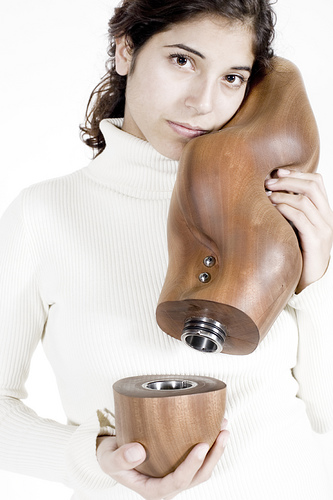Consumerism is tempting us on a daily basis: more objects, food, cloths and other products, some of which are not necessary at all. We are exposed to endless commercial content and other media that shape our perspective of what we should be, look like, and buy. It would seem that with time, we develop a certain numbness for the true needs of every person, and get carried away by the material world. Heart-Beans encompasses this formula, incorporating elements that its developers deem as basic needs – touch, and communication between a person and himself. To use this object, you must caress it and hug it, much like as a baby is held, the user inevitably bonds with it, emotionally. As a critical design piece, aimed to criticize society’s consumerism and our consumption culture, the students went through a process of developing a commercial device, even though this one is just a “one-of” artifact, without commercial value.
This project was developed and produced at the Bezalel academy for arts and crafts. The name of the project is “Heart Beans” and it is the creation of students of “Food for Thought” course, department of jewelry.
What it is
Ultimately, Heat-Beans is a coffee-grinder, set to operate according to the user’s heart-beats. It is a personal product from quality mahogany, in which a motor is built, controlled by an apparatus to measures the pace of the beating heart (HBM, Heart Beat Monitor); also included are peripheral electronics that bind it all together and allow it to work.
This machine gives a physical expression to the emotional state of the user and by its design – induce an experience of intimacy with the process of making coffee.
Holding the grinder is similar in pose and essence to holding a baby or a musical instrument, very affectionately. This is to simulate the relationship we have with other things we so care about, so to eventually bring about the same closeness here. And yet, as the grinder adhere the heart-beats, it produces a different taste with each use.
How it came to be
Student started development with a functional ergonomic approach, always taking in account the human body. They researched the different manners of grinding coffee, looking for the ultimate source of quality, and eventually choosing to use the machinery of the traditional manual coffee grinder to use as a platform for building the motor. In addition, a process commenced for defining the goal for the appeal of this product – touch, intimacy and desirability.
As for the design, sketches where made from readily available materials at hand. Several ways for coffee grinding were assessed and a motor was connected to a pace checking device. Three different models were initially created, from which only one was chosen as it embodied what this project strive for.

At first, a cast was made and wrapped around a net – to easily play with the shape and proportion and to deliberate between holding positions. Later measurements were taken and the choice of wood as a medium was made to expresses warmth and natural look. Other components were integrated, such as a LED to transform light beams and a receiver LED to tunnel the information to other parts. The final artifact features a wiring board by Hernando Barragán
Project by
Adi navwany , Michal shamsian , Itamar paloge and Danielle ram
Bezalel academy of arts and design / Department of Jewelry and fashion
This project was completed as part of Food for Thought, a course led by
Yaron Ronen , Jan-Christoph Zoels , Yaniv Steiner, Saar Shai and David Bortz